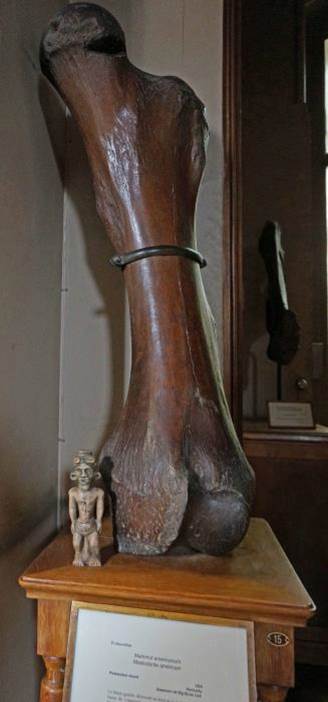The collections of the National Museum of Natural History in Paris include several mastodon bones from the Ohio River Valley and, in particular, Kentucky’s Big Bone Lick located just southwest of Cincinnati. Georges Cuvier, the father of paleontology, studied these bones and determined that they were from an extinct species, which initially he called simply the “Ohio animal.” Later, he named it the “mastodon.”

Mastodon femur from Big Bone Lick on display at the National Museum of Natural History in Paris photobombed by a replica of the Adena Effigy Pipe.
Cuvier’s discovery of extinction was a key element in the development of evolutionary theory. Elizabeth Kolbert, writing in the December 2013 issue of the New Yorker, noted that “Cuvier’s proof of extinction — of ‘a world previous to ours’ — was a sensational event, and news of it soon spread across the Atlantic.” In 1807, Thomas Jefferson instructed William Clark to conduct what has been called the first organized vertebrate paleontology expedition in the United States. Clark gathered several crates of bones from Big Bone Lick, a well-known fossil site that he and his partner Meriwether Lewis, had visited in 1803 in the first leg of their storied expedition to the West. Among the bones, Clark’s crew also found three flint spear points that we now recognize as Clovis points. These may well have been used to kill one or more of the mastodons and other animals represented in the collection though conclusive evidence of a direct association has been lost due to the way in which the material was excavated. In Kolbert’s essay, she describes her visit to the museum in Paris. The curator took her behind-the-scenes and showed her “the ‘Mona Lisa’ of paleontology” — a mastodon tooth that had been found in the Ohio River Valley by French soldiers in 1739 and that had figured prominently in Cuvier’s research. Later, in the main exhibit area, she came across another mastodon bone: “Just beyond the entrance, a giant femur, also sent from the Ohio River Valley to Paris, was displayed, mounted on a pedestal. It was as big around as a fence post. French schoolchildren were streaming past us, yelling excitedly.”

Clovis points recovered during William Clark’s expedition to Big Bone Lick, Kentucky in 1807. Image courtesy of the Cincinnati Museum Center.
I had the opportunity to visit the museum while in Paris to install the Adena Effigy Pipe at the Musée du quai Branly and although I didn’t have the time for a behind-the-scenes tour, I did track down the giant femur. Having participated in the excavation of a mastodon, it was fun seeing one of the historic specimens used by Cuvier to define the species. And when you include the fact that the bone is associated with the earliest documented discovery of Clovis points with extinct megafauna, then this femur, on display at the National Museum of Paleontology in Paris is important as history, archaeology and natural history. That’s almost enough to have me yelling excitedly, too!
Brad Lepper